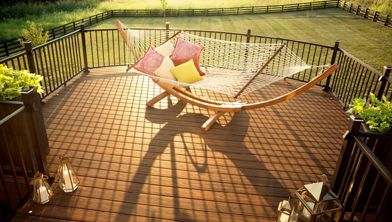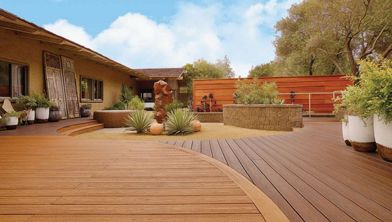What Are Standard Deck Railing Height Codes?
Learn about deck railing height codes, including requirements for stairs, baluster spacing, and local code differences, so your deck railing can be safe as well as stylish.
When you’re planning a deck, the safety and functionality of the railing system is one of the most important considerations. In addition to being a design feature, deck railings serve a critical role in preventing falls and ensuring structural integrity. However, the specific regulations regarding deck railing height can vary by location, making it crucial to understand the standard deck railing height codes in your area. Keep reading if you want to discover the key aspects of deck railing height codes, including general standards, local variations, and best practices. In this article, we will dive into the most common U.S. railing height requirements and codes.
What is the Maximum Deck Height Without a Railing?
Decks that are lower to the ground may not require a railing. According to the International Residential Code (IRC), decks that are less than 30 in. above grade (the ground) generally do not need a railing. The risk of receiving an injury from falling from such a low height is deemed minimal. Here is the exact language from the 2024 IRC International Residential Code for One- and Two-Family Dwellings. (The building code refers to railings as guards.)
R312.1.1 Where required.
Guards shall be provided for those portions of open-sided walking surfaces, including floors, stairs, ramps and landings that are located more than 30 inches (762 mm) measured vertically to the floor or grade below at any point within 36 inches (914 mm) horizontally to the edge of the open side. Insect screening shall not be considered as a guard.
Keep in mind that this provision can be influenced by your local building codes, which may have stricter requirements. For example, certain areas with specific safety concerns may require railings for decks that are even lower than 30 in. Additionally, decks near pools, stairways, or elevated structures may have additional restrictions. Also, you may want to install a railing even if one isn’t required. A 30-in. fall could still cause an injury, especially if the surface below the deck is made of concrete or other hard material.
What is the Standard Deck Railing Height Code?
For residential decks higher than 30 inches above grade, the IRC requires the minimum height of a railing to be 36 inches. The 36-inch height is designed to ensure the railing is tall enough to prevent accidental falls over the edge and minimize the risk of a child climbing up and over the top rail. It’s important to note that there are special code provisions for stairs, and while 36 in. is the minimum height in many locations. Also, local codes do vary from state to state, so always check with local building authorities before starting your deck project (more on this below).
Here's what the building code has to say:
R312.1.2 Height
Required guards at open-sided walking surfaces, including stairs, porches, balconies or landings, shall not be less than 36 inches (914mm) in height, as measured vertically above the adjacent walking surface or the line connecting the nosings.
Do Deck Railing Height Codes Vary?
Specific building codes for deck railings can vary by location. The IRC provides general guidelines, but many cities, counties, and states have adopted their own codes to address specific safety concerns. For example, California and Washington require a deck railing height exceeding 36 in, mandating a minimum of 42 in. for residential decks. Also, commercial or multifamily buildings may have stricter regulations that mandate 42-in. railings.
What are the Railing Height Requirements for Deck Stairs?
Following IRC code R312.1.2, the height requirements for deck stair railings are slightly different from standard horizontal deck railings due to the increased risk of falls on stairs. Stair guards must be at least 34 inches high when measured vertically from a line connecting the stair nosings. This ensures consistent protection along the slope of the stairs.
If the top of the stair guard also serves as a handrail, the height must fall between 34 and 38 inches from the nosing line. This range provides enough height for safety while still being comfortable and accessible to grip as a handrail.
These specific provisions help maintain both safety and functionality on stairways, which experience more movement and pose a greater fall hazard than flat deck surfaces. Always check local code amendments, as some areas may enforce stricter requirements.
What is the Railing Baluster Spacing Code and its Purpose?
In addition to the height of the deck railing, local codes regulate the spacing of the balusters, the vertical posts (sometimes called spindles) that make up the railing. This spacing requirement is designed to prevent small children from being trapped between the balusters or being injured in a fall.
The IRC mandates a 4-inch sphere should not be able to fit between any two components of the railing assembly, whether it be below the bottom rail and decking, between a post and baluster, or between two balusters. The spacing between balusters and between the balusters and posts on stairs is allowed to be 4-3/8 in., and the triangular space beneath the bottom rail and stair treads and risers must prevent a 6-in. sphere from passing through. Here is the specific language in the 2024 IRC that addresses baluster spacing:
R312.1.3 Opening limitations
Required guards shall not have openings from the walking surface to the required guard height that allow passage of a sphere 4 inches (102) millimeters in diameter.
Exceptions:
- The triangular openings at the open side of the stair, formed by the riser, tread and bottom rail of a guard, shall not allow passage of a sphere 6 inches (153mm) in diameter.
- Guards on the open side of stairs shall not have openings that allow passage of a sphere 4-3/8 inches (111 mm) in diameter.
This 4-inch sphere rule also applies to cable railing systems, but because cables have more give than solid materials like composite, metal, or glass, the cables on cable railing systems are usually spaced closer than 4 inches apart. Railing systems produced by premium manufacturers like Trex have these safeguards designed into their products, which makes installation easy and straightforward.
What is the Recommended Deck Railing Height?
Although the standard code requires railings to be a minimum of 36 in. for decks over 30 in. off the ground, there are often practical and aesthetic reasons for choosing a particular railing configuration. Keep these design considerations in mind:
- Consider installing a railing on decks lower than 30 in. to the ground when the surface below the deck is made of a hard material like concrete.
- You might want to install a railing on a lower deck to enhance safety for children, elderly individuals, or those with mobility challenges.
- For added safety, build railings taller than 36 in. if they are located near structures like planters or built-in benches, that a toddler might be tempted to climb.
- Many deck owners choose to build tall railings or walls to provide shade, add privacy, or serve as a wind or sound barrier.
Some choose to build railings to function as a cocktail rail, showcase planters or hold accent lighting, or simply for aesthetic reasons.
Find out More about Deck Railings
If you are still in the planning stages of your deck build, here is some helpful information about choosing the best deck railing. You can also explore these inspiring deck railing ideas, or for some helpful information on building deck railings, check out the how-to guides and videos at Trex Academy.
This content was partially or fully generated by AI and has been reviewed by our team to ensure accuracy and relevance.







































